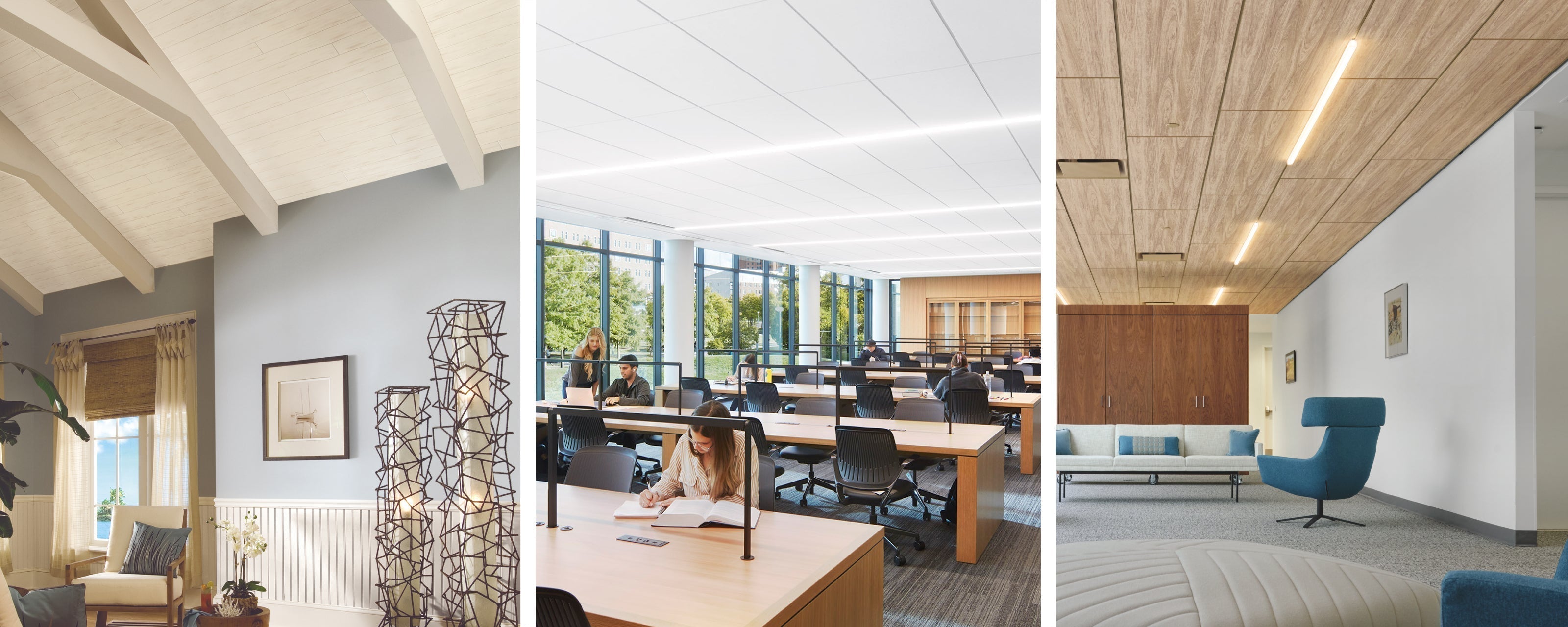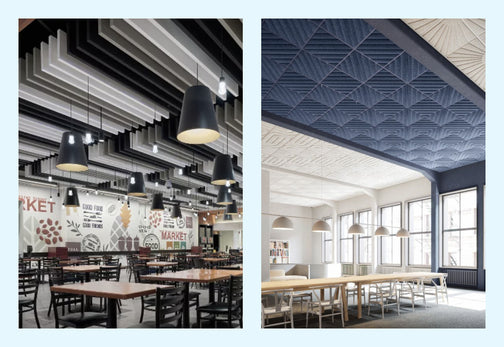Ceiling buying guide

Ceilings are more than just a finishing touch in a room. Whether in an office, commercial space, or your home, choosing the right ceiling can significantly impact the look and functionality of a space. Ceiling tiles enhance acoustics, improve energy efficiency, and contribute to your overall aesthetic appeal.
In this guide, we’ll explore:
• Types of ceiling tiles
• Factors to consider when buying ceilings
• How to choose the type of ceiling based on your space
• How much do ceilings cost?
Types of ceiling tiles
Understanding the different types of ceilings available can help you choose the best option based on appearance, functionality, and durability. Each type has distinct advantages suited for various spaces. Below, we explore the most common ceiling options and their benefits.
Drop ceiling tiles (suspended ceilings)
Drop ceilings, also known as suspended ceilings, are a popular choice for commercial offices, schools, hospitals, and basements. A drop ceiling consists of a metal grid system that holds lightweight tiles in place, creating a secondary ceiling beneath the original structure.
One of the biggest advantages of a drop ceiling is that it allows easy access to electrical wiring, HVAC ducts, and plumbing, making repairs, easy replacement, and upgrades simpler. Additionally, many suspended ceiling tiles are designed with acoustic properties, helping to reduce noise levels in busy environments. Fire-resistant and moisture-resistant options are also available for added safety and longevity.
Surface-mount ceiling tiles
Unlike drop ceilings, surface-mounted ceiling tiles are installed directly onto an existing ceiling, making them ideal for residential spaces, decorative renovations, and areas with lower ceilings. Surface-mount (aka direct-attach) tiles come in various materials, including foam, PVC, and metal. They are often used to cover popcorn ceilings or enhance aesthetics.
Installation methods vary, with options like glue-up, nail-up, and clip systems like the EASY UP Installation System, providing flexibility for both DIY projects and professional installations. Surface-mounted ceilings are an excellent choice for homeowners looking to revamp a room without extensive construction work.
Acoustic ceiling tiles
For spaces where sound control is a priority, acoustic ceiling tiles offer an effective solution. Did you know that acoustic ceiling tiles can reduce noise by absorbing sound waves, with some tiles absorbing up to 70% of sound, and can also help prevent sound from traveling to adjacent rooms. Making them ideal for open offices, conference rooms, schools, and theaters.
They are often made from fiberglass, mineral fiber, or perforated metal, each offering different levels of sound absorption. When selecting acoustic ceiling tiles, it’s important to consider the Noise Reduction Coefficient (NRC) and Ceiling Attenuation Class (CAC) ratings, which indicate their effectiveness in improving acoustics. Acoustic tiles also contribute to better indoor air quality by incorporating mold and mildew-resistant properties.
Tin and faux-tin ceiling tiles
Tin ceiling tiles provide a vintage, decorative appeal, making them a favorite in historic renovations, bars, restaurants, and stylish home interiors. Made from pressed metal, aluminum, steel, and even mineral fiber, tin tiles can add a touch of industrial charm or antique elegance to any space.
They are available in embossed, painted, or raw metal finishes, offering a variety of design options to suit different aesthetics. In addition to their aesthetic appeal, tin ceilings are durable, fire-resistant, and easy to clean, making them a practical and stylish ceiling solution.
Wood and wood-look ceiling panels
For those looking to create a warm, natural atmosphere, wood ceiling panels or wood-look alternatives are an excellent choice. Real wood panels add a high-end, rustic, or contemporary feel, depending on the finish and design. However, for a more affordable and low-maintenance option, faux wood panels made from PVC or fiberboard can achieve a similar look.
Common wood ceiling styles include tongue-and-groove planks, coffered ceiling infills, and wood finish baffles for commercial spaces. All of these add architectural interest to a room and are especially popular in boutique commercial spaces, living rooms, offices, and anywhere a cozy and sophisticated ambiance is desired.
PVC and plastic ceiling tiles
PVC and plastic ceiling tiles are known for their lightweight, moisture-resistant, and budget-friendly properties. PVC and plastic tiles are an excellent choice for bathrooms, basements, kitchens, and other high-humidity areas where traditional ceiling materials may warp or deteriorate over time.
Available in a range of colors, textures, and patterns, PVC ceiling tiles can mimic the look of tin, wood, or classic decorative panels without the maintenance requirements. Installation is easy and DIY-friendly, with options for direct glue-up or drop-in placement within a grid system. Since they resist mold, mildew, and stains, PVC tiles are a durable, long-lasting, and cost-effective ceiling solution.
Factors to consider when buying ceilings
Visual appeal
The ceiling plays a crucial role in the overall aesthetic of a room, often acting as a “fifth wall” that ties your interior design together. Choosing the right ceiling style, texture, and color ensures it complements the rest of your space, whether you're aiming for a sleek modern look, a warm rustic vibe, or a clean, professional environment.
Acoustics
If your priority is minimizing noise, opt for acoustic ceiling tiles specifically designed for sound absorption and noise reduction.
Installation method
Drop ceilings (suspended ceilings)
Drop ceilings, also known as suspended ceilings, consist of a metal grid system hung from the existing ceiling, with ceiling tiles laid into the grid. This setup allows for easy access to pipes, wiring, and ductwork, which is why it’s a popular choice in commercial and office environments.
Installation considerations: While drop ceilings are highly functional, the installation process can be complex. It involves precise measurements, leveling the suspension system, and securely mounting the grid, making professional installation the recommended route, especially in large areas. That said, skilled DIYers with experience in home renovation may be able to take this on with careful planning and the right tools.
Direct-mount or direct-attach ceilings
Direct-mount ceilings involve attaching tiles or panels directly to an existing ceiling surface using adhesive, nails, or a clip system. These are popular in residential settings where a lower ceiling profile or a decorative upgrade is desired without reducing ceiling height.
Installation considerations: Direct-mount ceilings are generally more DIY-friendly, particularly options that use adhesives or tongue-and-groove planks that snap together. These can be installed using basic tools like a level, utility knife, nail gun, or construction adhesive, making them a great weekend project for homeowners looking to refresh a room on their own.
Material and durability
Consider ceiling tiles that are moisture-resistant for basements, bathrooms, and kitchens. Wood and tin ceiling tiles, while visually striking, require additional maintenance but provide long-lasting durability.
Maintenance and cleaning
Regular maintenance keeps ceiling tiles looking fresh and extends their lifespan. Understanding the maintenance requirements of your chosen ceiling material will save you time and effort in the long run.
Cost and budget
Ceiling tile prices vary widely based on material, design, and performance. It's important to weigh all the aspects against your budget and long-term needs.
Energy efficiency
The advantages of utilizing energy-efficient ceiling tiles range based on the number of tiles installed and the local climate. Installing energy-saving ceiling tiles with PCM (phase change material) technology backing may reduce energy costs and consumption.
How to choose the type of ceiling based on your space
Selecting the right ceiling for your space depends on functionality, aesthetics, and environmental factors. Whether for a home, commercial setting, or industrial facility, different ceiling types serve unique purposes. Below, we break down the best ceiling options for various spaces.
Commercial spaces
Ceilings in commercial spaces must balance aesthetics, acoustics, and practicality. Offices, retail stores, restaurants, and hotels all have unique needs when selecting ceiling tiles.
• Offices: A productive workspace often requires acoustic ceiling tiles to reduce noise levels and improve clarity when speaking to one another. Drop ceilings with mineral fiber or fiberglass tiles are a common choice due to their sound-absorbing properties and easy access to HVAC and lighting systems.
• Retail stores: In retail environments, decorative ceiling tiles or suspended ceilings with sleek finishes create an inviting atmosphere for customers. Wood-look tiles, tin panels, or coffered designs add a premium feel to boutique stores.
• Restaurants & hotels: Restaurants and hotels need a balance of style and functionality. Metal, tin, or coffered ceiling tiles add elegance to dining areas and lobbies, while acoustic ceiling tiles in kitchens and conference rooms reduce noise. Moisture-resistant ceilings are also essential for maintaining hygiene in kitchens and restrooms.
Industrial spaces
Industrial settings such as warehouses, factories, and manufacturing facilities require durable, low-maintenance ceiling options that prioritize safety and efficiency.
• Warehouses & factories: These environments demand fire-resistant and impact-resistant ceiling tiles made of metal, gypsum, or mineral fiber. These materials withstand high temperatures, heavy machinery vibrations, and exposure to dust and chemicals.
• Manufacturing facilities: Facilities with high noise levels benefit from sound-absorbing ceiling tiles that reduce echo and improve worker communication. Additionally, spaces with exposure to moisture or chemicals should opt for PVC or fiberglass ceiling tiles for added durability.
• Cleanrooms & laboratories: For controlled environments such as cleanrooms and research labs, non-porous, antimicrobial ceiling tiles are necessary to meet strict hygiene standards. Vinyl-covered gypsum tiles are commonly used to prevent contamination.
Home spaces
Ceilings in residential spaces should enhance comfort, design, and functionality. The best ceiling tiles for homes depend on the room’s purpose:
• Living rooms & bedrooms: Homeowners often prefer decorative ceiling tiles that add texture and style. Wood-look tiles or tin tiles create a warm and elegant ambiance. If sound control is a priority, acoustic ceiling tiles help absorb noise for a quieter environment.
• Basements: Drop ceilings (suspended ceilings) are also popular, as they provide easy access to plumbing and electrical wiring.
• Kitchens & bathrooms: Kitchens and bathrooms require moisture-resistant ceiling tiles to withstand steam and humidity. Vinyl, PVC, or metal ceiling tiles are excellent options that prevent mold growth while offering a sleek, easy-to-clean surface.
Not sure what type of tile will look best? You can order an individual sample or shop sample bundles.
How much do ceilings cost?
The cost of ceiling tiles varies depending on several factors, including material, acoustic performance, safety certifications, aesthetic & design features, moisture & mold resistance, durability & longevity, and installation type. Whether you're looking for a budget-friendly ceiling solution or a high-end design, understanding these factors will help you make an informed decision.
Advice on your project is free. We have ceiling experts ready to help you quote your project.
Conclusion
Selecting the right ceiling tiles involves careful consideration of material, aesthetics, installation methods, and budget. Whether you’re looking for a practical, sound-absorbing solution for an office or a decorative finish for a home, there are ceiling tiles to suit every need. By understanding key factors such as durability, maintenance, and cost, you can make an informed decision that enhances the functionality and beauty of your space.
Additional resources:
• Shop by collection
• Choosing the right ceiling tile
• Drop ceiling installation
• Surface mount/direct attach ceiling installation
• How-to guide library









 Thanks for subscribing!
Thanks for subscribing!